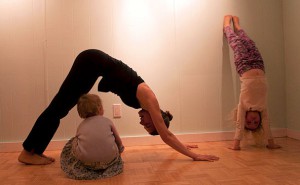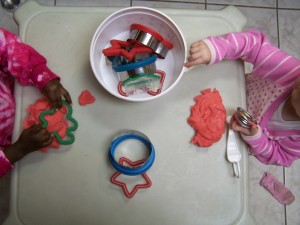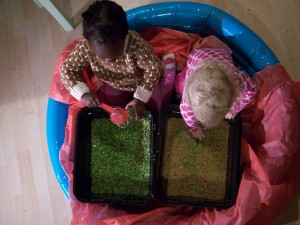By Kassandra Brown, parent coach in private practice at ParentCoaching.org.
 Your baby is crying at 3 a.m. It’s not the first time tonight you’ve gotten out of bed to answer her call and offer her your comforting arms and milk. You know she needs you and get up willingly, albeit groggily. You’re confident in Attachment Parenting International’s Eight Principles of Parenting and know you want to form a strong bond with your baby.
Your baby is crying at 3 a.m. It’s not the first time tonight you’ve gotten out of bed to answer her call and offer her your comforting arms and milk. You know she needs you and get up willingly, albeit groggily. You’re confident in Attachment Parenting International’s Eight Principles of Parenting and know you want to form a strong bond with your baby.
A few years later, you’re in the grocery store and your now preschool child is sprawled on the floor, screaming that she wants a candy bar. When you sit down beside her and try to comfort her, she screams louder and shrinks away, yelling, “Don’t touch me!” Your tools don’t seem to be working. You feel angry, embarrassed, confused and ashamed. Even worse, you notice an urge within you to slap her or yell at her to get her to stop. What went wrong?
Many parents, including me, have been in this situation. I know I had some illusions that if I just parented “right” and focused on good bonding behaviors to form secure attachments, then parenting would always be smooth sailing. I had some ideas like:
-
If I wear my baby, I can take her anywhere with me and continue my prebaby life.
-
My children won’t need to melt down, hit, scream or even cry because I’ll be so in tune with their needs.
-
My children will listen respectfully to each other and to me.
-
I will never yell.
-
Weaning will happen easily and naturally in a rhythm that works well for the whole family.
-
A secure attachment means I won’t have to set or maintain clear boundaries because my children and I will be kind and cooperative all the time.
-
Crying is a sign that I’m doing something wrong or that I’m not a good parent.
-
Attachment Parenting will make raising children easy.
Do any of these sound familiar? Yet the real world of parenting has not worked out that way for me or my clients. At first I wondered why not. Doesn’t Attachment Parenting work?
While grappling with these questions, I learned a few things about my own expectations for parenting and my emotional reactions to conflict. I’d like to share some tips that have made parenting a lot easier for me. I hope they inspire you, too.
Does AP Work?
Attachment Parenting is an overarching approach about treating children with love, compassion and respect. API’s Eight Principles of Parenting are wonderful tools that help guide parents in caring for their children. When difficult parenting moments arise, it is not a failure of the principles. AP is not a recipe for turning out angelic kids, but rather one for nurturing relationships.
When we ask the question “Does it work?” we need to define what we mean by “working.” If working means that kids and parents behave perfectly, as in the bullet points above, then no it doesn’t work–and neither does anything else in the real world. Relating to other human beings is hard, no matter what.
If working means building the strong foundations upon which loving relationships can be created, then yes it works. If working means creating an environment in which children are listened to, respected and guided with unconditional love, then yes it works.
Why Do I Lose It With My Kids?
We lose it with our kids for so many reasons: we care so much about them, we feel responsible for them, they remind us of ourselves when we were children, we fear what their attitudes and behaviors may mean for their future, we are sensitive to what other parents think about us and our children, and we are sometimes stressed or ill ourselves. Things that felt overwhelming to us as children will come up again. Children help us develop more self-awareness, compassion, tolerance and strength. Many times they do this by triggering our anger, aggression, shame, sadness, insecurity, fear and intolerance. When these emotions arise, we have two main options: repress the emotions or examine them.
How Many Beach Balls Are You Trying To Submerge?
Repressing a strong emotion can be a useful strategy, especially in emergencies. Imagine your child in a swimming pool. She’s just gotten into water over her head but doesn’t know how to swim. You don’t want to sit beside the pool talking to your friend about how you feel scared and nervous or what you think might happen. You want to put your own fear on hold while you jump in to save your child. In this instance, repressing your own fear is a useful and appropriate strategy that allows you to act now and feel later.
However, we get into trouble when we use repression as our “everyday” coping strategy. Trying to repress emotions over the long term is like trying to submerge a beach ball and keep it under water. It takes a lot of energy, balance and concentration. Then just when you think you’ve got the hang of it and let your energy shift to something else, the ball gets away from you and pops up anyway.
Like a beach ball that wants to float, emotions want to come to the surface. Even when we repress them, they often emerge when we least want them to. Multiply that by several different emotions and the different situations that trigger them, and it’s clear why suppressing emotions is a recipe for both exhaustion and failure.
Most of us want more for ourselves and our children.
Tips for Working with Anger and Other Challenging Emotions
1. Cool down. In the heat of the moment, it’s almost impossible to resist the urge to fight, flee or freeze unless you can soothe your stress response. Cooling off will help you more closely align your actions with your values.
10 Tips for Cooling Down:
-
Take 10 deep breaths and make a wordless sound on the exhale.
-
Resist the urge to rationalize. Let yourself feel exactly what you are feeling without trying to make it better or worse and without trying to justify yourself. Admit out loud that right now you are angry, upset, sad, frustrated, incensed or whatever else you are feeling. Breathe through your feelings and let them pass. For help in identifying your needs and feelings, the Center for Nonviolent Communication offers a needs list and a feelings list.
-
Remove distractions: turn off the devices (TV, computer, music), stop multi-tasking and focus on your child. Both of you will feel better when you’re not distracted or fighting for each other’s attention.
-
If you can safely leave the room for a few minutes, let your child know when you’ll be back and take a parent time-out. (This may or may not be appropriate based on your child’s age, developmental stage and the presence of another caregiver.)
-
If you are shopping, leave the shopping cart and go outside. You can cool off together in the car, do jumping jacks on the sidewalk, or run around a grassy space.
-
Move your body. Exercise is a great way to discharge energy without hurting anyone.
-
Change the scenery. Just walking into a different room or outside can help.
-
Look through your child’s eyes. Bend down or sit at his level. Look in the direction he is looking. Notice what the world is like from this point of view.
-
Write or draw in a journal to express how you feel, what you are thinking, what you want, and any blocks you see to getting what you want. Give your child paper and markers to join you and call this an “art time-out.”
-
At a time when you are calm, make a list of ways to cool off, and post it in a visible place in your house. When stress is creeping up on you, look at your list and do something from it.
2. Listen. Every moment of upset is an opportunity to parent in alignment with your values. Listen to what your child is saying. Then put yourself in her shoes and listen to what you are saying. Your child is small, dependent and not sure of how the world works. What do you want to say to her?
Listening Tip: To support your listening skills, try this visualization exercise:
Take a quiet moment at the start of the day. Listen to your breath for 10 breaths. This will help you settle into your body and feel calm. Then imagine a situation with your child that really bothers you. Imagine how you usually respond. Then imagine how you’d like to respond. Allow this new response to become very vivid; try to connect with the love and compassion you feel for your child. Taking the quiet time in your own mind to rehearse how you want to respond makes it more likely that you will respond that way in the future.
See the Listening Exercises at the end of this article for more in-depth listening tools.
3. Stop the Blame Game. Taking ownership of your own needs and feelings allows you to stop blaming your child for why things are not going right. The situation then becomes an opportunity for self-reflection and adjustment rather than a sign of failure. Listening for needs and feelings can be like learning a new language. It takes time, but it’s worth it as a way to de-escalate conflict and establish connection. It’s worked with inner city gangs, and it can work in your family.
Communication Tip: Ask yourself–What am I feeling; what do I need right now; what was I thinking right before I got upset; are my expectations reasonable? Then you can communicate in age-appropriate ways how you feel and what you need. If you practice using “I” statements, it’s easier for others to hear you. For example: “I feel angry and sad. I want to live in a clean and peaceful home where everyone helps out. I’d like to hear what you want and how you feel. Then I’d like to brainstorm about ways we can both get our needs met.” This is more respectful and effective than saying “I’m mad at you because you didn’t wash the dishes. You never wash the dishes. You’re so ungrateful.”
4. Reframe the Conflict. This step is also a good starting point for next time. When you can examine the conflict with an open heart and the intent to learn and be changed, you set the basis for a new and more powerful way to live your life and parent your children. Conflict happens. The question is, what are you going to do with it?
4 Tips to Open Your Heart After a Conflict:
-
Assume good intent. When you choose to assume your child is doing the best he can to meet a valid need with the tools he has, you respond differently than when you assume your child is a manipulative, ungrateful or lazy. Try it and see.
-
Tell yourself you are an awesome parent. Imagine that it’s true. It is.
-
Look for the gifts. What can you take away that will help you next time? Conflict can be a way to gain more understanding of the needs you share with your child.
-
Let the conflict be a way of creating more teamwork and shared problem solving with your child. Brainstorm about ways for both of you to have your needs met. Examples include time in nature, rest, good food and loving attention.
5. Forgive Yourself. Taking the time to work with the intense, challenging or disappointing moments is hard. Your own high expectations make it harder. Do you expect yourself to be perfect, and feel guilty or angry when you’re not? Just as punishment won’t help kids learn and grow, treating yourself harshly won’t lead to positive changes.
Forgiveness Tip: Forgive yourself for your breakdowns, tantrums and less-than-desirable behavior. When you are gentle with yourself, you model self-kindness to your children. Taking time to admit your mistakes and apologize to your children is also good modelling and a way to build connection.
What’s the Payoff?
Using conflict as an opportunity to wake up, grow and heal will change your life. Viewing conflict in terms of people clashing over different strategies for getting their needs met is very empowering. This work can offer big rewards in the quality of your parenting and your enjoyment of time with your children. The strong bonds that API’s Eight Principles of Parenting help you form make it easier. I know this has made a big difference in my life, and I hope you will find it valuable as well.
Resources
Talk to a good friend with as much honesty and vulnerability as you can.
Join a women’s or men’s group.
Join or start an API support group in your area.
Join the API Neighborhood.
See API’s resources for nurturing empathy.
Learn more about Nonviolent Communication.
Listening Exercise, Part 1
This part of the exercise can be done in a quiet moment during your day, when you know you will have at least 10 to 15 minutes alone. Get comfortable and breathe deeply for 10 breaths, just to help you settle in and be calm. Then imagine a situation involving your child that really bothers you. As an example, perhaps your child ignores you when you ask for help around the house. Remember a recent time when this happened. Think of what you were doing and saying, how you felt, what your child did and what you imagine he was thinking. You might need to pause and come back to your breath here because it takes effort not to get upset all over again while remembering. Now think about how you usually respond. Again, you might need to reconnect with your breath because it’s easy to get caught in this story.
Now try a radical shift. Imagine someone asks you to do something. But maybe you don’t really hear them or know what they mean. You don’t understand why it’s important. You don’t want to stop what you’re doing and do the thing that’s being asked or demanded of you. Allow yourself to travel back to a moment like this when someone–maybe your spouse, your boss or your own parents–asked something of you. How did you feel? How did you respond? Noticing what you felt and the validity of those feelings is a great first step towards change. Take that moment of insight and allow it to bring you into more compassion for your child.
Use your insight to imagine how you want someone to treat you in that situation. Would you like that person to be sure to get your attention? Maybe touch your arm and make eye contact rather than just throw words over her shoulder as she walked through the room? Maybe you want some context as to why the job is important? Maybe you want to be able to say you don’t think it’s important or it’s too hard or you just don’t want to do it? Maybe this job seems easy to everyone else but is hard for you, so you take on a belief that you are stupid or incapable every time you attempt the job? Allow yourself to be curious if any of these things are true for your child. Then offer him the same compassion and courtesy you’d like to be offered.
Listening Exercise, Part 2
This next part can be done with your child Suppose the task in question is something like washing the dishes after dinner. Suppose your child knows the dishes need to be done, she knows why, and she even agrees it’s important, but every night it’s a nagging, foot-dragging pain in everyone’s butt to get them done. The first step might be to uncover why it’s such a big deal. Why does your child resist, and why do you insist and nag? What are the underlying needs and feelings that are being triggered by the dishes? Is there something else your child would rather be doing? Does your child feel she has a voice in this situation? Is this a microcosm of resentment for you and a reminder of how you didn’t even want to cook dinner, let alone do all the dishes too? There could be any number of needs and feelings for both of you.
When you look at what’s going on, you’re better able to address the real causes of the behavior. Maybe after you uncover the needs and feelings about the task, you propose to your child that you both brainstorm three different solutions and then try them for one week each. At the end you will agree on one of them or try something new to make sure everyone’s needs are met. It may seem like it takes a lot of time to do this. But you don’t need to do it every night. Do it once, thoroughly. Then put a plan in place and try to stick to it.
This is just an example; both you and your child will bring your own creative genius into solving the problem once you are able to bridge the gap between you with listening and respect.

 In the United States alone, there are 3.2 million referrals to social services on allegations of child maltreatment each year — one-quarter of which are found to have a substantiated case of physical or sexual abuse or severe neglect. Seventy-five percent of these founded cases of abuse or neglect had no prior history. It’s an astounding number of children who aren’t living in safe, loving homes — especially knowing that these numbers don’t count the abused and neglected children living around the world. It’s a number that child maltreatment prevention researcher David Zielinski, PhD, wants to stick in your mind.
In the United States alone, there are 3.2 million referrals to social services on allegations of child maltreatment each year — one-quarter of which are found to have a substantiated case of physical or sexual abuse or severe neglect. Seventy-five percent of these founded cases of abuse or neglect had no prior history. It’s an astounding number of children who aren’t living in safe, loving homes — especially knowing that these numbers don’t count the abused and neglected children living around the world. It’s a number that child maltreatment prevention researcher David Zielinski, PhD, wants to stick in your mind. The hours of 4 p.m. to 6 p.m., known in the restaurant and lounge world as “Happy Hour,” have not been historically happy in my house. A more accurate term would be the “Wicked Hours.” The reason for this is that two essential
The hours of 4 p.m. to 6 p.m., known in the restaurant and lounge world as “Happy Hour,” have not been historically happy in my house. A more accurate term would be the “Wicked Hours.” The reason for this is that two essential 

 Are you tired of holding the bedroom door handle closed when your school-aged child is trying to leave during a timeout? Fed up with your child trashing his room during timeout? Frustrated because you can’t get your child to calm down and think about restitution during his timeout?
Are you tired of holding the bedroom door handle closed when your school-aged child is trying to leave during a timeout? Fed up with your child trashing his room during timeout? Frustrated because you can’t get your child to calm down and think about restitution during his timeout?
 We’ve all seen it – a mother losing her temper toward her child in the grocery store, or a father treating his child in a detached, ignoring or even hostile, way at the park. What should we do? What do we say? Perhaps the parent is usually loving and understanding and is just having a tough time at this moment. Or, maybe this is the parent’s standard response to his child.
We’ve all seen it – a mother losing her temper toward her child in the grocery store, or a father treating his child in a detached, ignoring or even hostile, way at the park. What should we do? What do we say? Perhaps the parent is usually loving and understanding and is just having a tough time at this moment. Or, maybe this is the parent’s standard response to his child. With toddlerhood comes tantrums. While some parents are taken by surprise by the seemingly violent appearance of a child raised in a non-violent home, it is a perfectly natural rite of passage for any child. The reasons behind it are simple: lots of emotions with little logic. The emotions that can overtake a toddler can be a floodgate of overwhelming proportions.
With toddlerhood comes tantrums. While some parents are taken by surprise by the seemingly violent appearance of a child raised in a non-violent home, it is a perfectly natural rite of passage for any child. The reasons behind it are simple: lots of emotions with little logic. The emotions that can overtake a toddler can be a floodgate of overwhelming proportions. Parenting during the teenage years is as trying on the young adult as it is on his parents. But if your child was adopted or if you’re fostering, the teenage years can be an especially tough time as your child tries to sort out his identity without knowing his birth parents or understanding the reasons why his birth parents are not a bigger part of his life.
Parenting during the teenage years is as trying on the young adult as it is on his parents. But if your child was adopted or if you’re fostering, the teenage years can be an especially tough time as your child tries to sort out his identity without knowing his birth parents or understanding the reasons why his birth parents are not a bigger part of his life.